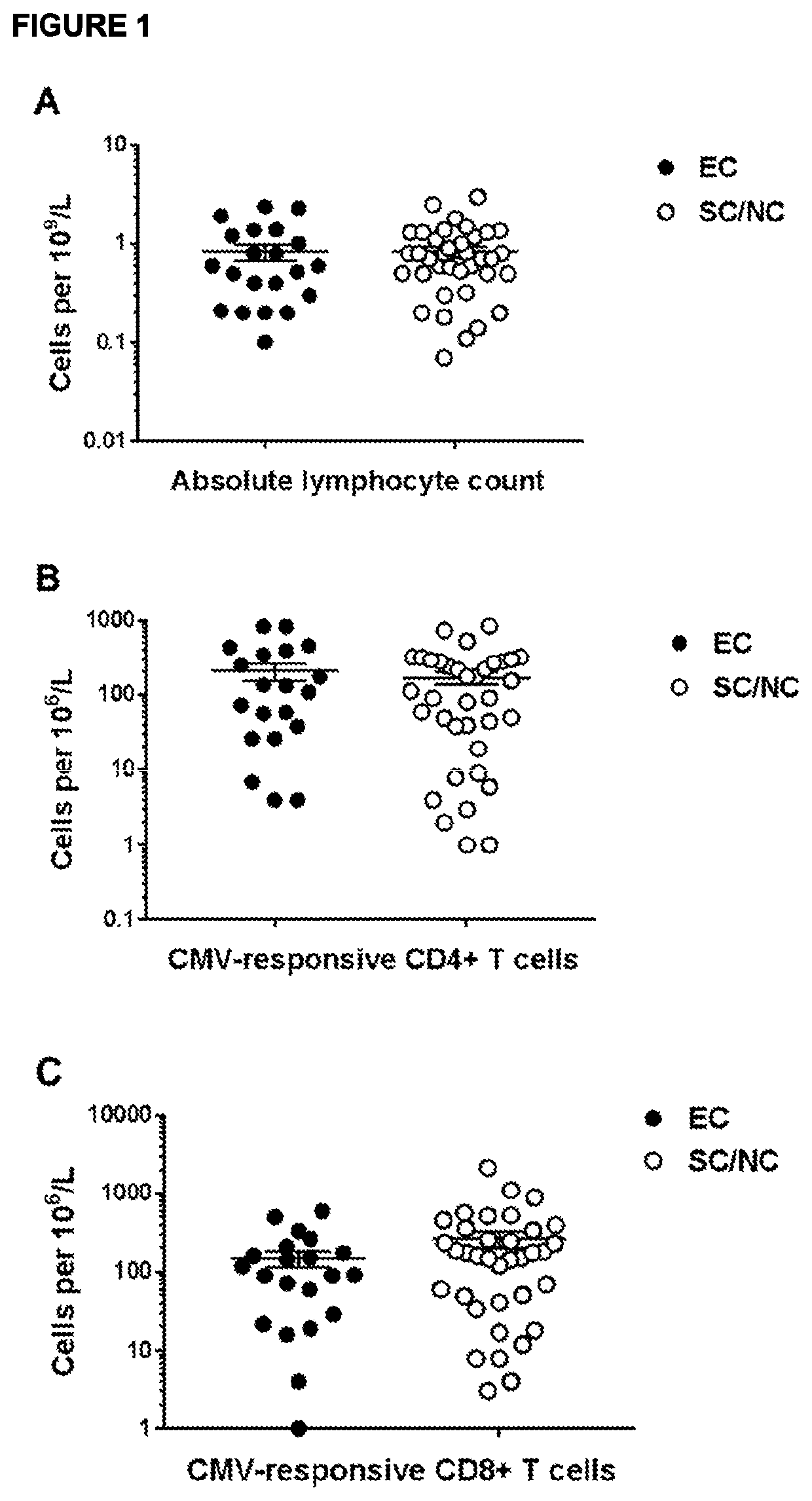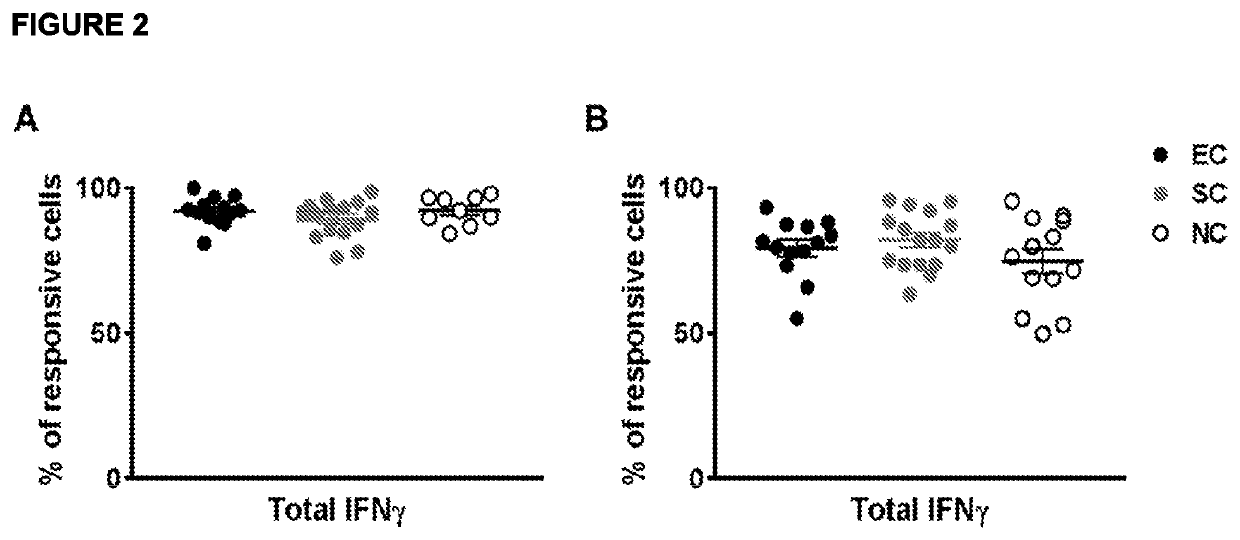Materials and methods for subjects at risk for viral reactivation
a technology for subjects at risk of viral reactivation and materials, applied in the field of infectious disease prevention and treatment, can solve the problems of increased risk of non-relapse mortality, significant morbidity and mortality, poor overall survival in the modern era, etc., and achieve the effect of improving health care and outcomes
- Summary
- Abstract
- Description
- Claims
- Application Information
AI Technical Summary
Benefits of technology
Problems solved by technology
Method used
Image
Examples
example 1
[0211]The following exemplary protocol is suitable for T cell analysis described herein. The assay is described with respect to assessment for risk for CMV reactivation, but similar procedures can be used for other viruses. Variations and equivalents will be apparent to scientists in the field.
[0212]Specimens:[0213]PBMC (either thawed from cryopreserved specimen or freshly prepared by ficoll centrifugation)
[0214]Plasticware:[0215]15 ml conical tube (Falcon cat #352097)[0216]96 well v-bottom plate (Nunc cat #249570)
[0217]Chemicals / Solutions:[0218]RPMI media (Gibco cat #22400-089)[0219]PBS (Corning cat #21-031-CV)[0220]Fetal Bovine Serum (FBS) (Seradigm cat #1400-500)[0221]Sodium Azide (Sigma cat # S8032)[0222]Brefeldin A (Sigma cat # B7651) in stock solution 10 mg / ml in DMSO stored at −80° C. in aliquots[0223]EDTA (Sigma cat # E7889)[0224]DMSO (Sigma cat # D2650)[0225]Staining buffer (SB) (PBS+10% FBS+0.1% (w / v) Sodium Azide)[0226]RPMI+10% FBS (RPMI / 10)[0227]Caltag Fix / Perm Medium A ...
example 2
[0295]Overview / Synopsis
[0296]The inventors have applied higher-order functional cytokine flow cytometry (CFC) to the assessment of clinical risk in immune-compromised (hematopoietic cell transplant, HCT) patients using a protocol essentially as outlined above in Example 1.
[0297]Peripheral blood mononuclear cells (PBMC) were isolated from blood samples drawn from thirty HCT recipients at day +30 after HCT. Based on monitoring for CMV reaction for period of thirty months, the HCT recipients were divided into three groups: Group 1: “Elite Controllers”—subjects with no observed CMV reactivation for 30 months following HCT; Group 2 “Spontaneous Controllers”—subject who experienced low level CMV reactivation, but the reactivation resolved without anti-viral therapy; and Group 3: “Non-controllers”—subjects who experienced higher level, uncontrolled CMV reactivation viremia requiring anti-viral therapy. The CMV serostatus of the hematopoietic cells did not appear to strongly correlate with ...
example 3
STRATIFICATION
[0302]Example 3 extends the initial results from Example 2 by incorporation of a larger sample of patients.
Overview / Synopsis
[0303]The inventors have applied higher-order functional cytokine flow cytometry (CFC) to the assessment of clinical risk in immune-compromised (hematopoietic cell transplant, HCT) patients using a protocol essentially as outlined above in Example 1.
[0304]Peripheral blood mononuclear cells (PBMC) were isolated from blood samples drawn from fifty-six HCT recipients at day +30 after HCT. Based on monitoring for CMV reaction for period of thirty months, the HCT recipients were divided into three groups: Group 1: “Elite Controllers”—subjects with no observed CMV reactivation for 30 months following HCT; Group 2 “Spontaneous Controllers”—subject who experienced low level CMV reactivation, but the reactivation resolved without anti-viral therapy; and Group 3: “Non-controllers”—subjects who experienced higher level, uncontrolled CMV reactivation viremia ...
PUM
| Property | Measurement | Unit |
|---|---|---|
| frequency | aaaaa | aaaaa |
| imaging cytometry | aaaaa | aaaaa |
| mass cytometry | aaaaa | aaaaa |
Abstract
Description
Claims
Application Information
 Login to View More
Login to View More - R&D
- Intellectual Property
- Life Sciences
- Materials
- Tech Scout
- Unparalleled Data Quality
- Higher Quality Content
- 60% Fewer Hallucinations
Browse by: Latest US Patents, China's latest patents, Technical Efficacy Thesaurus, Application Domain, Technology Topic, Popular Technical Reports.
© 2025 PatSnap. All rights reserved.Legal|Privacy policy|Modern Slavery Act Transparency Statement|Sitemap|About US| Contact US: help@patsnap.com



